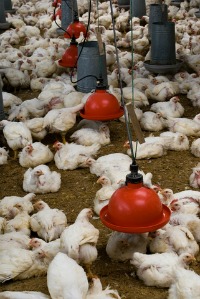Medicated Chicken Feed
Coccidiostats and/or antibiotics are the two most common medications added to medicated chicken feed. Coccidiosis is hard to control by sanitation practices alone.
It can be prevented by feeding a coccidiostat, or drug added to feed at low levels and fed continuously to prevent coccidiosis.
Medicated feeds are not organic. Here we present the pros and cons of this issue. When raising chickens for healthy organic eggs or meat, the use of medicated feeds is counterproductive.
Traces of medications may be transferred into the human food supply. A healthy alternative is food grade Diatomaceous Earth.
These fossilized plant cells contain trace minerals and can work in the digestive tract to eliminate coccidia as well as intestinal parasites. The minerals are beneficial and work leaving no traces of drugs or medication to be transferred to eggs or meat.
Medicated chicken feed with antibiotics can also be counterproductive to chicken health. Continuous feeding of antibiotics helps to create antibiotic resistant strains of bacteria, as well as destroying good digestive bacteria necessary for the best absorption of nutrients from foods.
I prefer not to use medicated feeds, although they can be valuable in treating specific problems, if they contain the right medication. Different types of bacteria call for different antibiotics.
A medicated feed may contain an antibiotic that will have no effect on what you want to treat. It may also interfere with beneficial bacteria that naturally keep “bad” bacteria levels in check.
When considering the healthiest diet for your chickens (and ultimately yourself), we must consider the use of medicated chicken feed and if the drugs and medications supplied in them is necessary or potentially harmful in the long run. Sunshine, fresh air, exercise, a balanced diet, a spacious and healthy environment is the best medicine.

Chicken factories growing meat and producing eggs often must rely on drugs and medications due to the stressful and unnatural environment they provide for chickens. This is the same industry that has removed the beaks of baby chicks to prevent stressed out and overcrowded chickens from harming each other.
These chickens are short lived, being kept alive by any means possible, to get the most out of them in the least amount of time, for the least amount of money. I think it’s good to decide if we want to copy any of this industry’s practices. Failure to be concerned about “food” raised in this manner might be considered negligent, at best.
Feed Broilers
In commercial slaughter houses medicated chicken feed ration containing a coccidiostat is feed until the last week before slaughtering then is switched to non-medicated feed during the final week.
Mature chickens develop a resistance to coccidiosis if allowed to contract a mild infection of the disease. Birds raised for placement in laying flocks are fed a coccidiostat containing feed until about 16 weeks of age.
The medicated feed is then replaced with a non-medicated feed. Spotty outbreaks are controlled by treating in the water with an appropriate coccidiostat.
Examples of coccidiostats added to the ration include:
Antibiotics may also be added to some poultry feeds. Antibiotics aid broiler performance and maintain healthy birds.
They are usually added at low (prophylatic) levels to prevent minor diseases and produce faster, more efficient growth. Higher (therapeutic) levels are usually given in water or injected into the bird.
Examples of antibiotics fed in medicated chicken feed are:
Follow the recommended medication withdrawal periods before eating meat or eggs from the treated birds. Follow all warning instructions listed on the feed label.
If you have a small flock and practice good sanitation, you should be able to raise chickens and bypass any type of medicated chicken feed.
We have learned from animals kept in zoos, that the best way to keep them happy and healthy, is to provide them with spacious enclosures that mimic their native surroundings and to give them diets that mimic what they would consume in their natural state. Chickens are no different, even after 8000 years of domestication.

Custom Search



New! Comments
Have your say about what you just read! Leave me a comment in the box below.